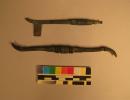Dr. Francis Rosenbaum, of the Milwaukee Academy of Medicine, donated a 36-piece collection of these reproductions to the MPM in 1954. This donation represents the majority of the collection – exceptions noted as appropriate. The original medical tools found in Pompeii are on display at the National Archaeological Museum in Naples.
The larger pieces – in particular the specula – are fascinating because they are so similar to tools used well into the 20th century. Anyone in the medical profession would easily recognize the function and purpose of the specula and many of the other tools.
Descriptions accompanying the photos are drawn primarily from J.S. Milne’s “Surgical Instruments in Greek and Roman Times” (1907).











